It looks like you're using an Ad Blocker.
Please white-list or disable AboveTopSecret.com in your ad-blocking tool.
Thank you.
Some features of ATS will be disabled while you continue to use an ad-blocker.
share:
A thread about The Ancient Egyptian Labyrinth, in which it will be considered as a Cultic centre of
Sobek the crocodile God, and it's likely present existence considered.
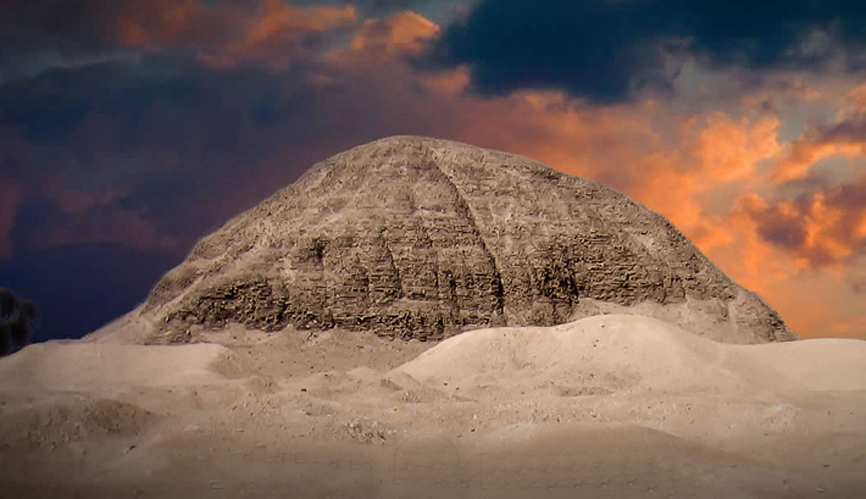
At present the Egyptian labyrinth is considered to have probably been the Mortuary Temple to the pyramid of Amenemhet III, and whilst there would have been such in the vicinity that cannot have been the Labyrinth the area of which is offset and too considerable in size to have represented such.
Herodotus mentions the crocodile vaults of the lower levels and that is a far more likely explanation of the Labyrinths purpose, as the Faiyum region was the centre of Sobek worship and the 12th Dynasty Kings that constructed there had him as their principle Deity.
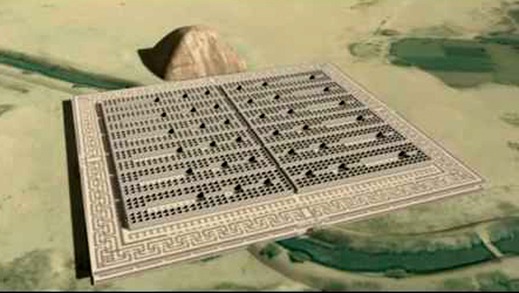
Suggested reconstructions then are along the lines of a Mortuary Temple but there is no evidence for this, there does appear the recurring suggestion of administrative buildings above ground as this was the centre of power at the period, but the greater purpose would have been religious
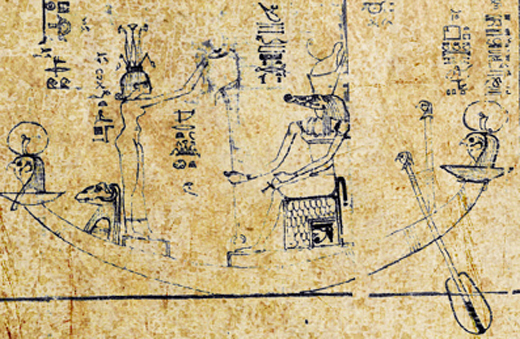
There is nothing to suggest the Ptolomies or Romans deconstructed the Labyrinth as Petrie supposed, indeed they were highly interested in the entire cult of Sobek of the Faiyum Oasis, the Atlantis Myth is based upon the tradition of Neith-Sobek from her Temple at Sais, were Sobek personified the warlike destructive tendencies.
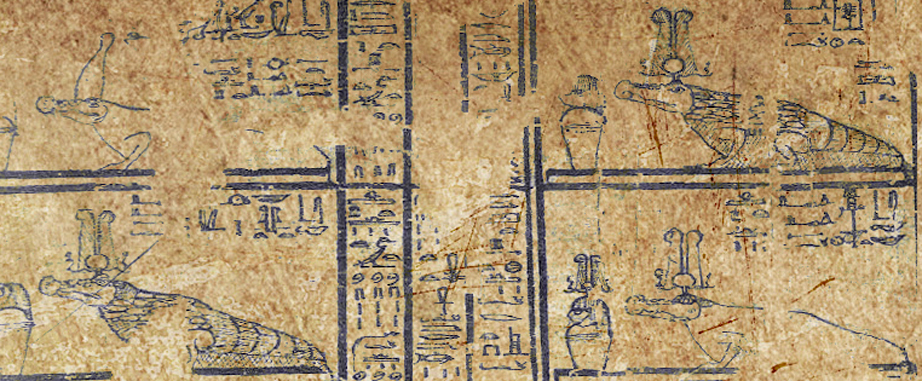
In Greek and Roman times the Book of the Faiyum was extremely popular ranking alongside the Book of Thoth, this relates to the Cult of Sobek and his cultic sites around the Faiyum, it seems likely then that this should also include the Labyrinth which i suggest was the princple cultic site, and indeed in the work can be seen concern with underground chambers and vaults to many Gods in the form of the schematic of the Papyrus, which scholars have thus far been unable to define an overall purpose for, relationship to the Labyrinth would explain the popularity and purpose.

Given the popularity then of the period and the fact that Greek and Roman writers maintained it was still there it seems unlikely they would have destroyed it, what is more likely is that the present base area is the roof of the labyrinth and that the huge depth of chippings that Petrie found constitute excavated material from within rather than masonry robbing debris, which rarely leaves such voluminous waste.
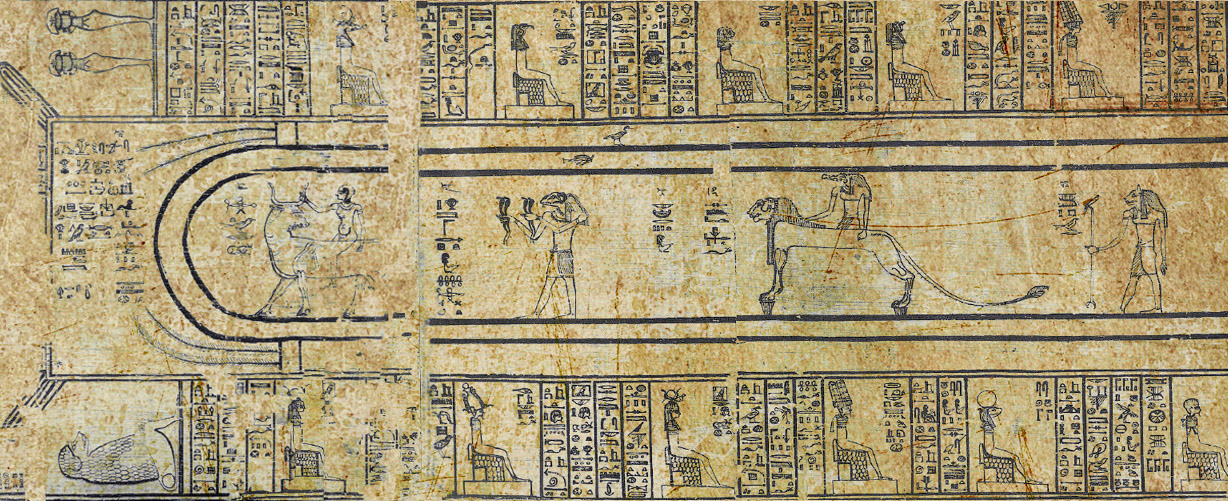
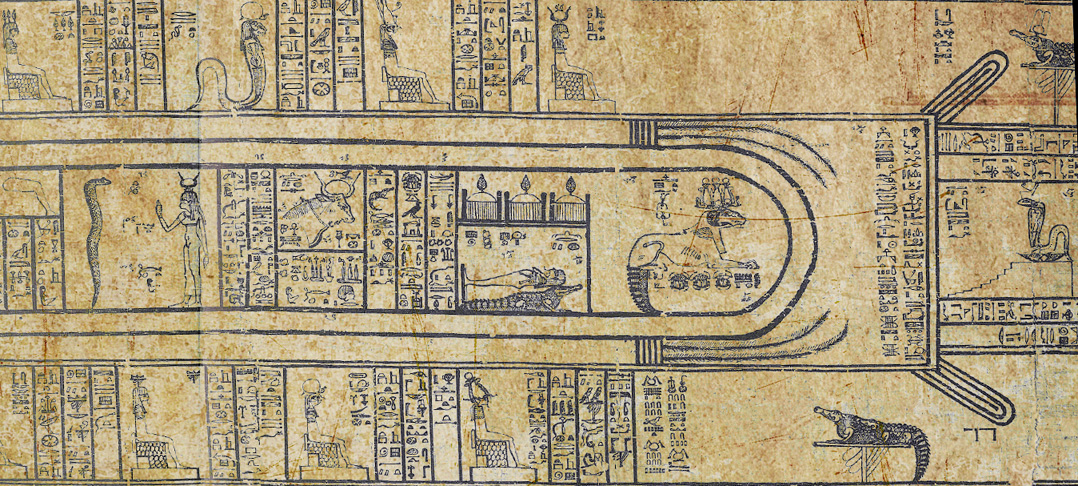
When the Mataha Expedition scanned parts of the base area in 2008 they found strong suggestion of complex chambers and walls several metres thick beneath the surface to considerable depth, and yet they were blocked in publishing their findings by Egyptian authorities and their work has not been followed up on since.
The fact that the supposed chambers are flooded may well also be the reason the labyrinth was lost to antiquity, that it became no longer possible to enter within and thus the site was generally abandoned, and thus the mysterious cultic centre of the crocodile God lost to the waters.

Das Buch Von Fayum

At present the Egyptian labyrinth is considered to have probably been the Mortuary Temple to the pyramid of Amenemhet III, and whilst there would have been such in the vicinity that cannot have been the Labyrinth the area of which is offset and too considerable in size to have represented such.
Herodotus mentions the crocodile vaults of the lower levels and that is a far more likely explanation of the Labyrinths purpose, as the Faiyum region was the centre of Sobek worship and the 12th Dynasty Kings that constructed there had him as their principle Deity.
We ourselves saw the aboveground chambers, for we went through them so we can talk of them, but the underground chambers we can speak of only from hearsay. For the officials of the Egyptians entirely refused to show us these, saying that there were, in them, the coffins of the kings who had built the labyrinth at the beginning and also those of the holy crocodiles. So we speak from hearsay of these underground places; but what we saw aboveground was certainly greater than all human works.

Furthermore, they resolved to leave a memorial of themselves in common, and in pursuance of this resolve they made a labyrinth, a little above Lake Moeris, and situated near what is called the City of the Crocodiles
Suggested reconstructions then are along the lines of a Mortuary Temple but there is no evidence for this, there does appear the recurring suggestion of administrative buildings above ground as this was the centre of power at the period, but the greater purpose would have been religious

There is nothing to suggest the Ptolomies or Romans deconstructed the Labyrinth as Petrie supposed, indeed they were highly interested in the entire cult of Sobek of the Faiyum Oasis, the Atlantis Myth is based upon the tradition of Neith-Sobek from her Temple at Sais, were Sobek personified the warlike destructive tendencies.
For the Greeks, Atlantis was built on one of Gaia’s (Earth’s) large land masses named Atlantic Island by sea god Poseidon whose palace was the focus of the city’s circular rings. And from the Egyptian stories, Bakhu was similarly constructed on Atum Island which was the primordial mound raised from Nun (Neith) the primeval water’s depths by several gods including sea god Sobek, who built his palace there and became Lord of Bakhu. These Egyptian creation theologies assert that Sobek, offspring of Neith, had laid eggs in the bank of the shoreline of Atum Island, which is clearly evocative of several circular rings embedded in the Earth. .

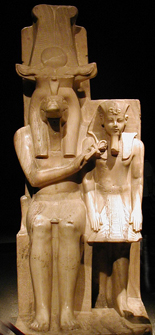
Sobek-Neferu is believed to have completed the fabled labyrinth monument at Hawara in the Faiyum Oasis, following the death of her father and brother. Following her death, which wound up both the Twelfth Dynasty and the Middle Kingdom period, the cult of Sobek continued through into the Second Intermediary Period, with no less than five kings with names honouring Sobek
It seems likely that Sobek began as a dark god who had to be appeased, but that his protective qualities and his strength were valued when they were used in defence of the Pharaoh and the people. He could protect the justified dead in the netherworld, restoring their sight and reviving their senses. Because of his ferocity, he was considered to be the patron of the army.
In Greek and Roman times the Book of the Faiyum was extremely popular ranking alongside the Book of Thoth, this relates to the Cult of Sobek and his cultic sites around the Faiyum, it seems likely then that this should also include the Labyrinth which i suggest was the princple cultic site, and indeed in the work can be seen concern with underground chambers and vaults to many Gods in the form of the schematic of the Papyrus, which scholars have thus far been unable to define an overall purpose for, relationship to the Labyrinth would explain the popularity and purpose.
In Ptolemaic and Roman Egypt, a "local monograph" called the Book of the Faiyum centered on Sobek with a considerable portion devoted to the journey made by Sobek-Ra each day with the movement of the sun through the sky. The text also focuses heavily on Sobek’s central role in creation as a manifestation of Ra, as he is said to have risen from the primal waters of Lake Moeris

Given the popularity then of the period and the fact that Greek and Roman writers maintained it was still there it seems unlikely they would have destroyed it, what is more likely is that the present base area is the roof of the labyrinth and that the huge depth of chippings that Petrie found constitute excavated material from within rather than masonry robbing debris, which rarely leaves such voluminous waste.

The primeval power of Sobek is already acknowledged in a hymn from the Pyramid Texts (PT 317), where the dead pharaoh identifies himself with the god, who here appears as son of the Great Neith-Meher-Weret, the celestial cow of the inundation: “Sobek, green of feathers, alert-looking, broad-chested, sparkling, coming out from the legs and the tail of the Great One, who is in splendour.”

The Greek historian Herodotus (c. 484–425 BC) noted that the Egyptian citizens of Sais in Egypt worshipped Neith and that they identified her with Athena. The Timaeus, a Socratic dialogue written by Plato, mirrors that identification with Athena, possibly as a result of the identification of both goddesses with war and weaving
Sometimes Neith was pictured as a woman nursing a baby crocodile, and she was titled "Nurse of Crocodiles". As mother of Ra, she was sometimes described as the "Great Cow who gave birth to Ra"
When the Mataha Expedition scanned parts of the base area in 2008 they found strong suggestion of complex chambers and walls several metres thick beneath the surface to considerable depth, and yet they were blocked in publishing their findings by Egyptian authorities and their work has not been followed up on since.
The fact that the supposed chambers are flooded may well also be the reason the labyrinth was lost to antiquity, that it became no longer possible to enter within and thus the site was generally abandoned, and thus the mysterious cultic centre of the crocodile God lost to the waters.

Das Buch Von Fayum
edit on
Kam430110vAmerica/ChicagoMonday2130 by Kantzveldt because: (no reason given)
Wow! I have never heard of this. Thanks for sharing. This would be a place that I'd love to visit if I ever made it to Egypt.
a reply to: Kantzveldt
Poor humans.
Hu=Snake
Man=Ape
Grow as much hair as you possibly can..it will help a little bit.
The subject is so ludicrous you will be funning David Icke for another 2000 years at least. That's how delusional most of you have become unfortunately.
Bloomberg is one of them...surprised you cannot see it.
Poor humans.
Hu=Snake
Man=Ape
Grow as much hair as you possibly can..it will help a little bit.
The subject is so ludicrous you will be funning David Icke for another 2000 years at least. That's how delusional most of you have become unfortunately.
Bloomberg is one of them...surprised you cannot see it.
edit on 21-4-2014 by superluminal11 because: (no reason given)
a reply to: Kantzveldt
Kantz, you may color me convoluted, but I see great parallels.
source
Excellent once again. SnF
a reply to: superluminal11
Ludicrous? I wonder if you can look beyond hate and see fear. Or is that also ludicrous?
Kantz, you may color me convoluted, but I see great parallels.
Now the serpent was more subtle and crafty than any living creature of the field which the Lord God had made. And he [Satan] said to the woman, Can it really be that God has said, You shall not eat from every tree of the garden?
source
Excellent once again. SnF
a reply to: superluminal11
The subject is so ludicrous you will be funning David Icke for another 2000 years at least.
Ludicrous? I wonder if you can look beyond hate and see fear. Or is that also ludicrous?
edit on Ram42114v57201400000053 by randyvs because: (no reason given)
edit on Rpm42114v06201400000040 by randyvs because: (no
reason given)
a reply to: Kantzveldt
Perhaps back in those days, due to climate change in Egypt, the nile floods gave rise to an expansion of the crocodile population.
Leading to an elevation in status of the crocodile cult.
Perhaps back in those days, due to climate change in Egypt, the nile floods gave rise to an expansion of the crocodile population.
Leading to an elevation in status of the crocodile cult.
a reply to: randyvs
The Crocodile Sobek was associated with first creation, the Faiyum the place of the First Time-Zep Tepi, in fact it played the role of overcoming the subterranean serpent and making the break through from below to the above.
The first red banding of sunrise was seen as the carnelian Temple of Bakhu at the mountain of the horizon, and in terms of colour symbolism this reflected the essential violence of birthing, for this reason also the crocodile is seen related to the constellation Draco and the Hippo that gives birth, Tawret, as well as the constellation Hydra.
The crocodile was to the Egyptians what the dragon was to the Mesopotamians.

a reply to: midicon
The crocodile had always been a mojor Egyptian Deity, in times of unrest and uncertainty he became more popular as he represented taking of things by force, perhaps also explaining his popularity with the Greeks and Romans
"Unis is Sobek, green of plumage, with alert face and raised fore, the splashing one who came from the thigh and tail of the great goddess in the sunlight…Unis has appeared as Sobek, Neith’s son. Unis will eat with his mouth, Unis will urinate and Unis will copulate with his penis. Unis is lord of semen, who takes women from their husbands to the place Unis likes according to his heart’s fancy.
Sobek wasn't one to mess around with.
a reply to: superluminal11
At the birth of any New World Order the crocodile will play a role...guaranteed.
The Crocodile Sobek was associated with first creation, the Faiyum the place of the First Time-Zep Tepi, in fact it played the role of overcoming the subterranean serpent and making the break through from below to the above.
The first red banding of sunrise was seen as the carnelian Temple of Bakhu at the mountain of the horizon, and in terms of colour symbolism this reflected the essential violence of birthing, for this reason also the crocodile is seen related to the constellation Draco and the Hippo that gives birth, Tawret, as well as the constellation Hydra.
The crocodile was to the Egyptians what the dragon was to the Mesopotamians.

a reply to: midicon
The crocodile had always been a mojor Egyptian Deity, in times of unrest and uncertainty he became more popular as he represented taking of things by force, perhaps also explaining his popularity with the Greeks and Romans
"Unis is Sobek, green of plumage, with alert face and raised fore, the splashing one who came from the thigh and tail of the great goddess in the sunlight…Unis has appeared as Sobek, Neith’s son. Unis will eat with his mouth, Unis will urinate and Unis will copulate with his penis. Unis is lord of semen, who takes women from their husbands to the place Unis likes according to his heart’s fancy.
Sobek wasn't one to mess around with.
a reply to: superluminal11
At the birth of any New World Order the crocodile will play a role...guaranteed.
edit on Kpm430110vAmerica/ChicagoMonday2130 by Kantzveldt
because: (no reason given)
a reply to: Kantzveldt
And the further explanation isn't exactly a SUBTLE further confirmation
of the parallels. But more of an expansion on CRAFTY as I see it.
So much more between heaven and hell, rings true.
And the further explanation isn't exactly a SUBTLE further confirmation
of the parallels. But more of an expansion on CRAFTY as I see it.
So much more between heaven and hell, rings true.
edit on Rpm42114v232014u25 by randyvs because: (no reason given)
a reply to: randyvs
Possibly, the Egyptians saw things in terms of a subtle continuous process of transformation, were the Atum serpent gives rise to the crocodile in terms of violent upheaval and change.
It is generally considered the Hebrew term Messiah owes something to the sacred anointing of the crocodile as King, that one who exerts his will to rule by force, and certainly in Egypt this was the case.
Possibly, the Egyptians saw things in terms of a subtle continuous process of transformation, were the Atum serpent gives rise to the crocodile in terms of violent upheaval and change.
It is generally considered the Hebrew term Messiah owes something to the sacred anointing of the crocodile as King, that one who exerts his will to rule by force, and certainly in Egypt this was the case.
The strength and speed of the crocodile was thought to be symbolic of the power of the Pharaoh, and the word "sovereign" was written with the hieroglyph of a crocodile. It was thought that Sobek could protect the Pharaoh from dark magic. During the Twelfth and Thirteenth Dynasties, the cult of Sobek was given particular prominence and a number of rulers incorporated him in their coronation names
a reply to: randyvs
I loved the illustrations of the Book of Fayum, those are my own created reconstructed presentations, there was only the odd vignette to be found in online images, i just think the work should be more considered with regards to the Labyrinth.
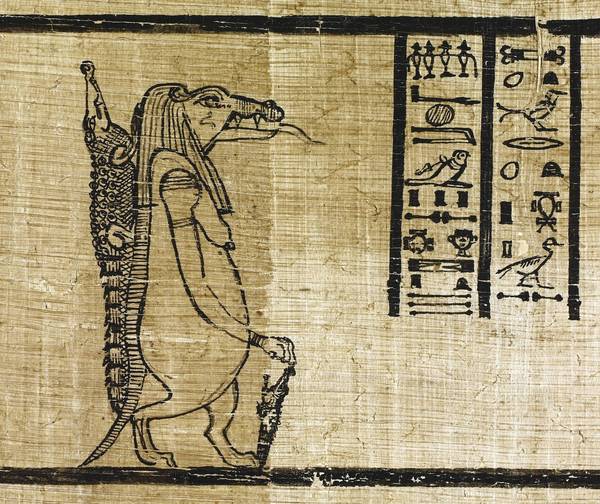

I loved the illustrations of the Book of Fayum, those are my own created reconstructed presentations, there was only the odd vignette to be found in online images, i just think the work should be more considered with regards to the Labyrinth.


a reply to: Kantzveldt
Great Job! Flagged earlier and OP just starred after re-reading...
I too have never heard of this. I'm certainly no Egyptologist but I have a keen interest in this area and this one is completely new to me.
Now I have to follow your source material and dig into this a little deeper.
Damn you Kantzveldt....and thanks!
BTW - what are your thoughts regarding some bigger picture here related to other areas of Egyptology or beyond? Your post seems to be primarily factual in nature but I get the sense this interests you beyond the "facts" presented...
Great Job! Flagged earlier and OP just starred after re-reading...
I too have never heard of this. I'm certainly no Egyptologist but I have a keen interest in this area and this one is completely new to me.
Now I have to follow your source material and dig into this a little deeper.
Damn you Kantzveldt....and thanks!
BTW - what are your thoughts regarding some bigger picture here related to other areas of Egyptology or beyond? Your post seems to be primarily factual in nature but I get the sense this interests you beyond the "facts" presented...
a reply to: Riffrafter
In terms of the bigger picture my interest here is the correlation between the Mesopotamian Dragon born Annunaki Kings and the Egyptian variant of the crocodile.
Both share the same relationship to 'the Celestial Cow', the cults of Neith and Hathor and the role of their Astral counterpart the Pleiades and Sirius in giving birth to the Dragon/Crocodile, the symbolic language is consistent and the principles based in nature.
It is uncertain which Kings were understood to have been buried in the Labyrinth but they would have related to the First Time, in general terms i would expect these underground chambers to be at least the equivalent of the Serapeum and by repute much greater.
I find it strange the seemingly obvious relationship to the cult of Sobek hasn't been previously considered for the Labyrinth and how readily it has been dismissed on facile premises and publication of the scannings was considered as against Egyptian National Security interests!
There seems to be fear and denial involved...
In terms of the bigger picture my interest here is the correlation between the Mesopotamian Dragon born Annunaki Kings and the Egyptian variant of the crocodile.
Both share the same relationship to 'the Celestial Cow', the cults of Neith and Hathor and the role of their Astral counterpart the Pleiades and Sirius in giving birth to the Dragon/Crocodile, the symbolic language is consistent and the principles based in nature.
It is uncertain which Kings were understood to have been buried in the Labyrinth but they would have related to the First Time, in general terms i would expect these underground chambers to be at least the equivalent of the Serapeum and by repute much greater.
I find it strange the seemingly obvious relationship to the cult of Sobek hasn't been previously considered for the Labyrinth and how readily it has been dismissed on facile premises and publication of the scannings was considered as against Egyptian National Security interests!
There seems to be fear and denial involved...
a reply to: Riffrafter
I just want to clarify that for me, it isn't only what's," Beyond the facts ".
But just as much the possibility we see a very brief description, of the
same," facts " in other ancient texts, that certainly point to their historical
vindication in riciprocation. Even ex post facto, for lack of a better term,
is of interest i.e. the naming of astrological constellations.
I get the sense this interests you beyond the "facts" presented...
I just want to clarify that for me, it isn't only what's," Beyond the facts ".
But just as much the possibility we see a very brief description, of the
same," facts " in other ancient texts, that certainly point to their historical
vindication in riciprocation. Even ex post facto, for lack of a better term,
is of interest i.e. the naming of astrological constellations.
Brilliant effort, thank you for the op and introduction to an aspect of Egyptology I was unacquainted with. I m particularly intrigued by the
correlation you have made to the Atlantis myth, I need to break out some of my dusty volumes and look into this further.
Thank you
Thank you
a reply to: BlueJacket
Thanks it seems clear enough that the mythos a Priest of the Temple of Neith would relate would be the creation mythos involving Neith and Sobek, and that Plato elaborated upon this with regards to Neith being correspondent to Athena and the principle of Sobek giving rise to war.
Having figured this i'm not sure why the writer of the Atlantis Bakhu article should then bother to consider the location of an actual Atlantis, as for the Egyptians that place of first creation would have been the Faiyum and an island upon the lake, but perhaps there was also some interest in the Labyrinth at Hawara representing Ante-Diluvian architecture.
For the Egyptians the mountain of the horizon which had the carnelian temple of Bakhu at it's base was the magical mountain of light and transformation, it was the zodiacal light along the ecliptic plane seen before sunrise, so no specific place, and of course the pyramids represented that mountain as places of transformation.
Thanks it seems clear enough that the mythos a Priest of the Temple of Neith would relate would be the creation mythos involving Neith and Sobek, and that Plato elaborated upon this with regards to Neith being correspondent to Athena and the principle of Sobek giving rise to war.
Having figured this i'm not sure why the writer of the Atlantis Bakhu article should then bother to consider the location of an actual Atlantis, as for the Egyptians that place of first creation would have been the Faiyum and an island upon the lake, but perhaps there was also some interest in the Labyrinth at Hawara representing Ante-Diluvian architecture.
For the Egyptians the mountain of the horizon which had the carnelian temple of Bakhu at it's base was the magical mountain of light and transformation, it was the zodiacal light along the ecliptic plane seen before sunrise, so no specific place, and of course the pyramids represented that mountain as places of transformation.
a reply to: Kantzveldt
Another excellent piece, Kantzveldt!
Wish I could contribute past stars, flag and thanks...but, they will have to do (at least, for the time being).
So - THANKS.
Another excellent piece, Kantzveldt!
Wish I could contribute past stars, flag and thanks...but, they will have to do (at least, for the time being).
So - THANKS.
a reply to: Kantzveldt
Good schtuff.
I just happened upon the labyrinth as I was researching the bronze serpent. I didn't read much but was wondering if you see a connection with the labyrinth of aesclepius and or other labyrinths.
Good schtuff.
I just happened upon the labyrinth as I was researching the bronze serpent. I didn't read much but was wondering if you see a connection with the labyrinth of aesclepius and or other labyrinths.
a reply to: zardust
The best indication of what a labyrinth was about and were it was located in an Astral sense is from Sumeria;
Enki and the World Order
The text translation is a little confusing i feel in that it places the Labyrinth 'by' the Field Constellation (the square of Pegasus), i think more properly it should simply indicate 'at'
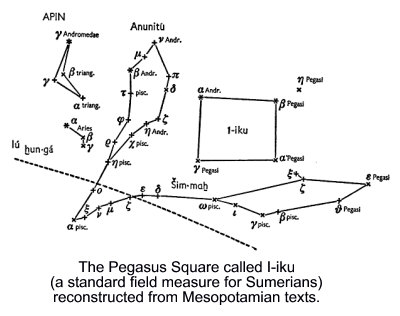
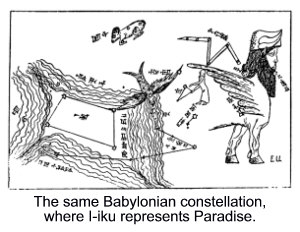
Gilgamesh journeys through the Zodiac
I think the Egyptian Labyrinth would have had the same basis, a place of order, regulation and complexity in the midst of the waters, place of first land and establishment of measure, it is the reptilian Crocodile then Lord of the Waters that unites the two principles of water-land.

a reply to: WanDash
Thanks you're very kind, one of the fringe benefits from this research for me is that it has been the basis for contact with the Faerie collective that dwell within the square, and they really are the fringe
The best indication of what a labyrinth was about and were it was located in an Astral sense is from Sumeria;
The lord established a shrine, a holy shrine, whose interior is elaborately constructed. He established a shrine in the sea, a holy shrine, whose interior is elaborately constructed. The shrine, whose interior is a tangled thread, is beyond understanding. The shrine's emplacement is situated by the constellation the Field, the holy upper shrine's emplacement faces towards the Chariot constellation. Its terrifying sea is a rising wave, its splendour is fearsome. The Anuna gods dare not approach it. …… to refresh their hearts, the palace rejoices. The Anuna stand by with prayers and supplications. They set up a great altar for Enki in the E-engura, for the lord ……. The great prince ……. …… the pelican of the sea
He demarcated borders and fixed boundaries. For the Anuna gods, Enki situated dwellings in cities and disposed agricultural land into fields. Enki placed in charge of the whole of heaven and earth the hero, the bull who comes out of the ḫašur forest bellowing truculently, the youth Utu, the bull standing triumphantly, audaciously, majestically, the father of the Great City (an expression for the underworld),
Enki and the World Order
The text translation is a little confusing i feel in that it places the Labyrinth 'by' the Field Constellation (the square of Pegasus), i think more properly it should simply indicate 'at'


As Utnapishtim recounts the story of the flood to Gilgamesh, he tells him that Enki warned him that Enlil planned to destroy humanity and that Utnapishtim should build an ark shaped exactly like a cube ("her length and breadth shall be the same"). This is a strange detail until we realize that for the Mesopotamians the constellation of Pisces included the so-called Pegasus Square between the two fish, and that this square was known as "1 Iku," precisely the dimensions of the ark (an iku was a unit of measurement equivalent to 3600 square meters).
Gilgamesh journeys through the Zodiac
I think the Egyptian Labyrinth would have had the same basis, a place of order, regulation and complexity in the midst of the waters, place of first land and establishment of measure, it is the reptilian Crocodile then Lord of the Waters that unites the two principles of water-land.

a reply to: WanDash
Thanks you're very kind, one of the fringe benefits from this research for me is that it has been the basis for contact with the Faerie collective that dwell within the square, and they really are the fringe
edit on Kam430111vAmerica/ChicagoTuesday2230 by Kantzveldt because: (no reason
given)
a reply to: Kantzveldt
I found this interesting in the link above
Nergal is associated with Resheph, and Resheph is also known as Sydyk in Phoenecia. Sydyk is the father of Eshmun aka Aesclepius. Though there is a conflation between Resheph and Eshmun/Aesclepius.
I didn't get into these aspects much but in The Cult of the Bronze Serpent I look at Eshmun/Aesclepius a little bit.
This site about Jason and the Argonauts has some interesting connections between Gilgamesh and Eshmun.
My interest in Resheph stems from the Qodesh Stele (I discuss this overlay of the tabernacle with the stele in my sig link)
[atsimg]http://files.abovetopsecret.com/files/img/bf53301279.jpg[/atsimg]
I see Resheph and Min as Gemini here, also shown as the two ibex flanking the tree of life. Both Resheph and Min have dual natures of killing and healing in and of themselves also. The bronze labyr and door mentioned in the quote from your Gilgamesh link relates to the outer court of the Israelite temple. Bronze was only found in the outer court, and I think that is where Neshustan was displayed, likely in the doorway to the inner court. D the fourth letter is a door, and symbolizes the 4 pillars of the earth, the 4 papyriform pillars overlaid as the djed, the 4 little Horae, And was a miniature of the zodiac, represented as the 4 faces of the cherubim.
Resheph may derive his name as a metathesis of Seraph, the Seraphim. You mentioned the dragon lords, so I thought I'd point Resheph out to you as a chthonic deity, that may be a good connector in your search. (If you haven't already, I just know theres not a lot out there about him). Notice the snake is on Reshephs side.
He is also known as Apollo.
I found this interesting in the link above
Gilgamesh and Enkidu are meant to be an incarnation of the constellation which we now refer to as Gemini. Gilgamesh was explicitly identified in a late text with the god Meslamta-ea (note the "mes" prefix) which name is the oldest known of that of the god Nergal, whose temple at Kutha was called "Emeslam." Meslamta-ea, furthermore, was one of a pair of deities whose counterpart was known as Lugal-irra, both of whom were linked astronomically with Gemini. These two gods were twins, and they were specifically associated with guarding doorways, particularly the gateway to the underworld, where they stood with bronze axes waiting to dismember the dead.
Nergal is associated with Resheph, and Resheph is also known as Sydyk in Phoenecia. Sydyk is the father of Eshmun aka Aesclepius. Though there is a conflation between Resheph and Eshmun/Aesclepius.
I didn't get into these aspects much but in The Cult of the Bronze Serpent I look at Eshmun/Aesclepius a little bit.
This site about Jason and the Argonauts has some interesting connections between Gilgamesh and Eshmun.
My interest in Resheph stems from the Qodesh Stele (I discuss this overlay of the tabernacle with the stele in my sig link)
[atsimg]http://files.abovetopsecret.com/files/img/bf53301279.jpg[/atsimg]
I see Resheph and Min as Gemini here, also shown as the two ibex flanking the tree of life. Both Resheph and Min have dual natures of killing and healing in and of themselves also. The bronze labyr and door mentioned in the quote from your Gilgamesh link relates to the outer court of the Israelite temple. Bronze was only found in the outer court, and I think that is where Neshustan was displayed, likely in the doorway to the inner court. D the fourth letter is a door, and symbolizes the 4 pillars of the earth, the 4 papyriform pillars overlaid as the djed, the 4 little Horae, And was a miniature of the zodiac, represented as the 4 faces of the cherubim.
Resheph may derive his name as a metathesis of Seraph, the Seraphim. You mentioned the dragon lords, so I thought I'd point Resheph out to you as a chthonic deity, that may be a good connector in your search. (If you haven't already, I just know theres not a lot out there about him). Notice the snake is on Reshephs side.
He is also known as Apollo.
a reply to: zardust
In general i would see Aesclepius as the young Horus and his power over dark forces, such as serpents and scorpions and their bites and stings, this could also be his consort Hathor-Isis, the basis of this power literally was seen to stand upon mastery of the power associated with the crocodile, which i would place as being located at the square of Pegasus in the Astral sense, and associate with the mysteries of the Labyrinth, hence the reason Aesclepius could be associated with such.
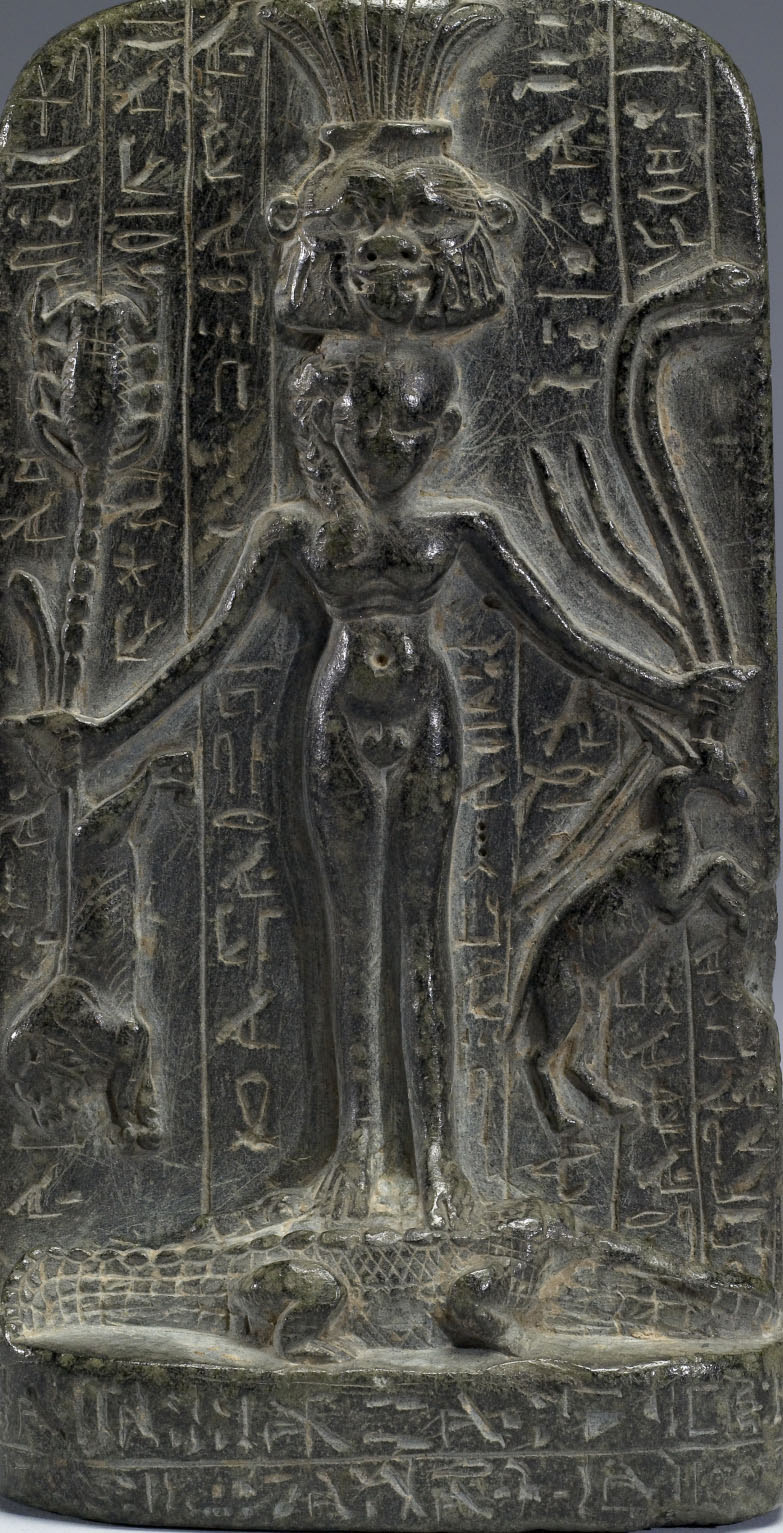


These magical cippus of the Late Period represented in black as the concern is with power over dark forces. There were Semtic variants of these as you say in Qudosh and Reshaph, they can also be seen in conjunction with what would have been the stag and Panther constellations in Sumeria, Andromeda and Perseus, thus in the region of Pegasus.
The association with the likes of Nergal and the Underworld is due to that point of contact between life and death, the below and the above, the power to restore life and overcome death.
In general i would see Aesclepius as the young Horus and his power over dark forces, such as serpents and scorpions and their bites and stings, this could also be his consort Hathor-Isis, the basis of this power literally was seen to stand upon mastery of the power associated with the crocodile, which i would place as being located at the square of Pegasus in the Astral sense, and associate with the mysteries of the Labyrinth, hence the reason Aesclepius could be associated with such.



These magical cippus of the Late Period represented in black as the concern is with power over dark forces. There were Semtic variants of these as you say in Qudosh and Reshaph, they can also be seen in conjunction with what would have been the stag and Panther constellations in Sumeria, Andromeda and Perseus, thus in the region of Pegasus.
The association with the likes of Nergal and the Underworld is due to that point of contact between life and death, the below and the above, the power to restore life and overcome death.
edit on Kam430111vAmerica/ChicagoTuesday2230 by Kantzveldt because: (no reason given)
new topics
-
Democrats send letter to Biden urging him to ratify Equal Rights Amendment
US Political Madness: 12 minutes ago -
This is adorable you guys!
General Chit Chat: 11 hours ago
top topics
-
Reprehensible Behavior
US Political Madness: 12 hours ago, 10 flags -
Those Drones over NJ and elsewhere
Aliens and UFOs: 17 hours ago, 8 flags -
This is adorable you guys!
General Chit Chat: 11 hours ago, 8 flags -
South Korean coup was an attempt to start WW3
World War Three: 17 hours ago, 7 flags -
Archer aviation and the NJ drones
Aircraft Projects: 17 hours ago, 5 flags -
Defending the need for adherence to Old Testament commandments under the new covenant of Christ
Conspiracies in Religions: 13 hours ago, 5 flags -
Democrats send letter to Biden urging him to ratify Equal Rights Amendment
US Political Madness: 12 minutes ago, 0 flags
active topics
-
Democrats send letter to Biden urging him to ratify Equal Rights Amendment
US Political Madness • 0 • : xuenchen -
Defending the need for adherence to Old Testament commandments under the new covenant of Christ
Conspiracies in Religions • 24 • : FullHeathen -
Light from Space Might Be Travelling Instantaneously
Space Exploration • 26 • : GotterDameron23 -
-@TH3WH17ERABB17- -Q- ---TIME TO SHOW THE WORLD--- -Part- --44--
Dissecting Disinformation • 3713 • : 777Vader -
Rant. I am sick of people saying the police are revenue raising.
Rant • 12 • : inflaymes69 -
Reprehensible Behavior
US Political Madness • 10 • : nugget1 -
George Stephanopoulos and ABC agree to pay $15 million to settle Trump defamation suit
Mainstream News • 24 • : WeMustCare -
Drones everywhere in New Jersey ---and Elsewhere Master Thread
Aliens and UFOs • 174 • : nugget1 -
The Mystery Drones and Government Lies --- Master Thread
Political Conspiracies • 106 • : cherokeetroy -
Statements of Intent from Incoming Trump Administration Members - 2025 to 2029.
2024 Elections • 45 • : WeMustCare
